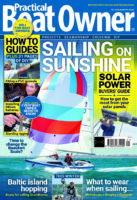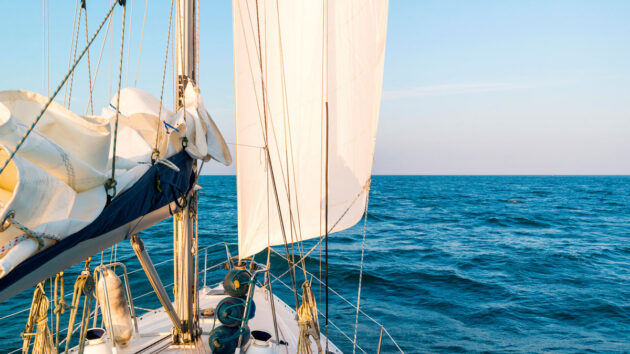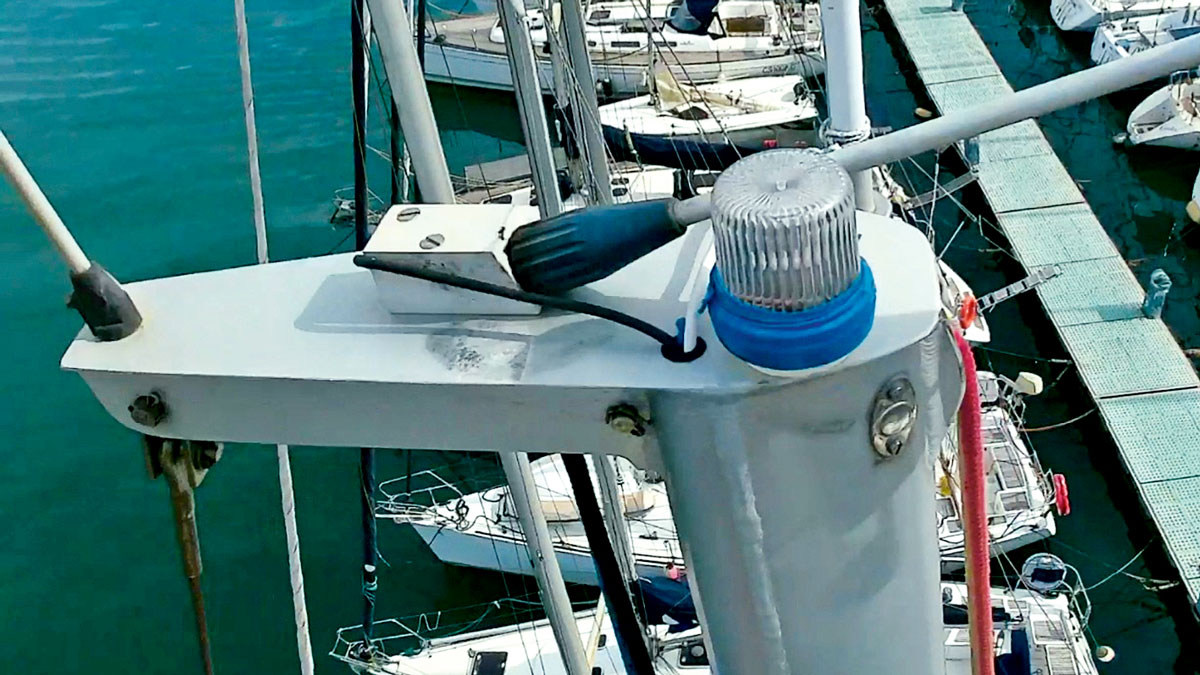Your yacht’s rig remains upright thanks to the right balance of compression and deflection, as Owen Brown explains
Late last summer, we bought an Eagle 525, a lovely pocket sailing cruiser, for our retirement. It was our first foray into keelboat ownership.
We’re by no means inexperienced, having sailed on and off for over 50 years, but most of our sailing has been in dinghies – and simple dinghies at that – like the GP14.
Our biggest challenge with the Eagle 525 was understanding the rig – how to tune it for a good sailing performance while preventing it from toppling.
Having bought our yacht late in the season, our sailing trips were limited to about half a dozen outings, and then only in modest winds – nothing over Force 3-4.
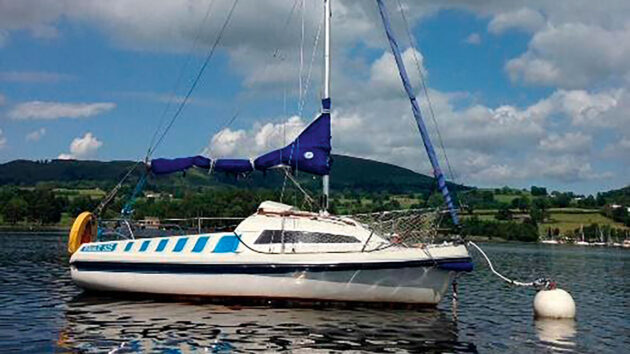
Morton Eagle 525 is towable behind an average family car. The spacious cockpit easily accommodates four adults. Credit: Owen Brown
We were cautious because of the uncertain age of the boat rigging; and although a pre-purchase survey had revealed no serious concerns, we preferred to take things slowly.
We studied her sailing performance critically. There was scope for improvement, particularly on the wind. I noted that the leeward shrouds waved about lazily when close-hauled, but I lacked both the knowledge and the confidence to make the necessary adjustments.

A traditional dinghy with an unstayed rig. Credit: Tony Liley/Alamy
During the winter lay-up, I researched the matter, even constructing a computer model to show the forces at work when I couldn’t visualise their interaction.
I think it has given me a good insight into the mechanics of a yacht mast and standing rigging system.
I’m certainly no expert, but often an explanation by someone who has struggled to grasp a concept is more easily understood by others.
Deflection – boat rigging basics
My first boat, Linnet, was a 10ft clinker dinghy. Built in Wroxham on the Broads from mahogany, she was a very old bird when we bought her for £60 in 1966.
She had a single blue cotton standing lug sail on a through-thwart unstayed wooden mast. The mast was roughly the length of the boat and about 3in diameter.
As far as masts and rigging go, this is as simple as it gets – the mast resists the sail force by bending like a tree in a strong breeze.
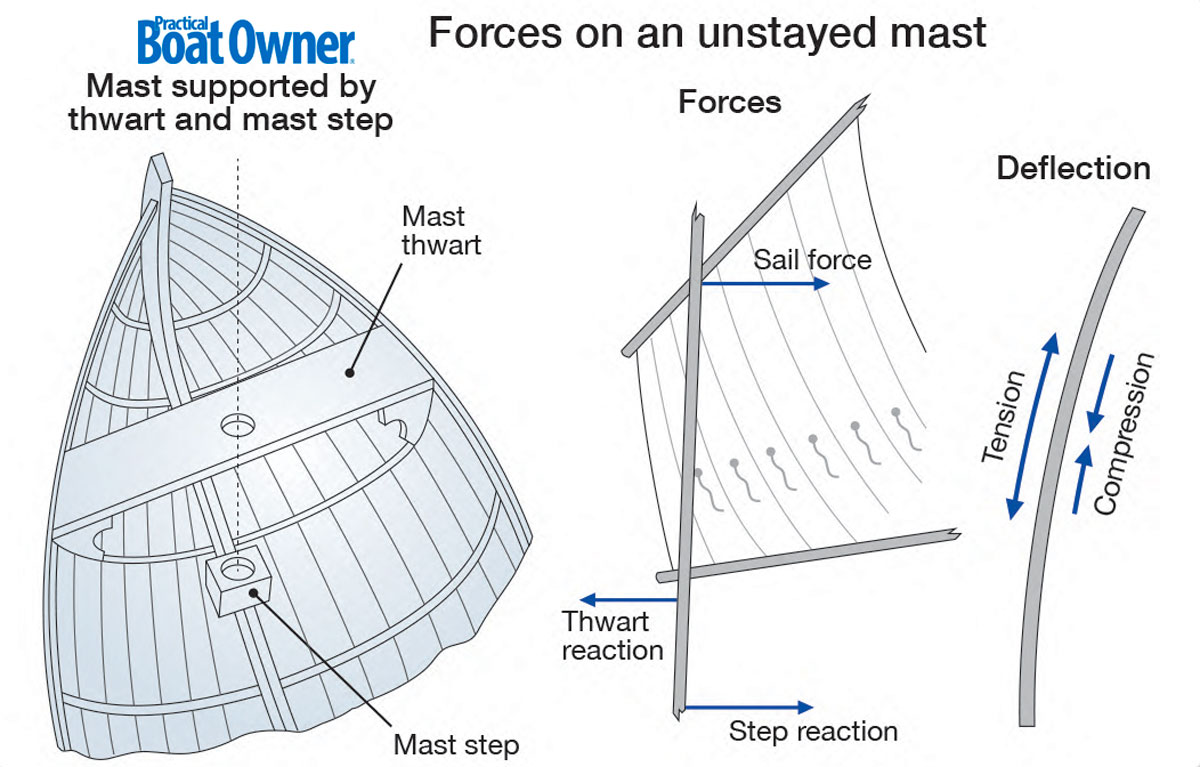
Boat rigging: Forces on an unstayed mast
This force is transmitted to the boat’s hull, propelling it forward, through the reactions of the thwart and mast step in stopping the mast toppling over, as shown in the diagram above.
The stresses in the mast come from its deflection: the material on the outside of the bend is stretched, and that on the inside is compressed.
This sets up two opposing forces of the same magnitude inside the mast which gives it the strength to resist bending.
Failure of the mast in this type of rig would be due to insufficient bending strength.
Mast buckling
My second boat was a GP14 dinghy with a through-deck aluminium mast supported by forestay and shrouds, but at that time, no spreaders.
That mast was about 20ft in length and not much bigger in cross-section than Linnet’s and hollow to boot.
Sometimes, when sailing through a particularly vicious gust, I’d look up at the mast straining against the bar-tight windward shroud and suppress thoughts of the invisible forces threatening to tear away the whole rig.
The magnitude of these forces was dramatically demonstrated in one blustery regatta handicap race in the early 1970s when the mast of an Albacore dinghy was driven, like a javelin, through the bottom of the boat.
I remember joining the small crowd gathered around the crippled boat after it had been pulled from the water to gaze in awe at the mast, all askew, protruding about 6in out through the bottom of the hull – such is the compression on the mast exerted by the tension in the shrouds, as shown in the diagram below.
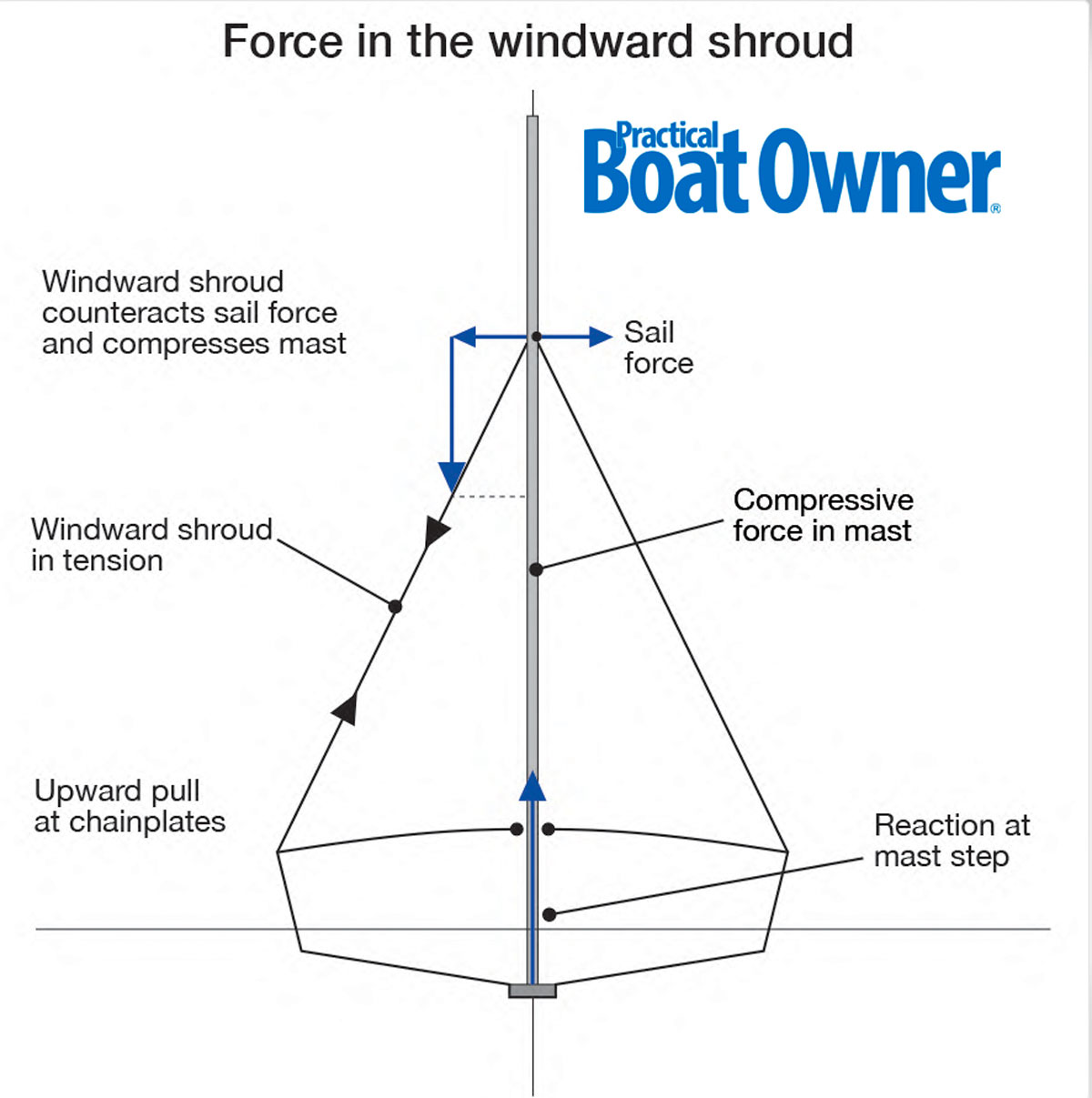
Boat rigging: Force in the windward shroud
As the mast deflects under the force of the sails, the windward shroud becomes increasingly taut.
At the chainplates, the tension literally pulls up the windward side of the yacht, causing it to heel.
At the hounds, the tension exerts a windward pull on the mast while simultaneously forcing it downwards against the mast step.
Failure of the mast in this type of rig (if it isn’t forced through the bottom of the hull first) would be due to its instability under compression, ie it would buckle.
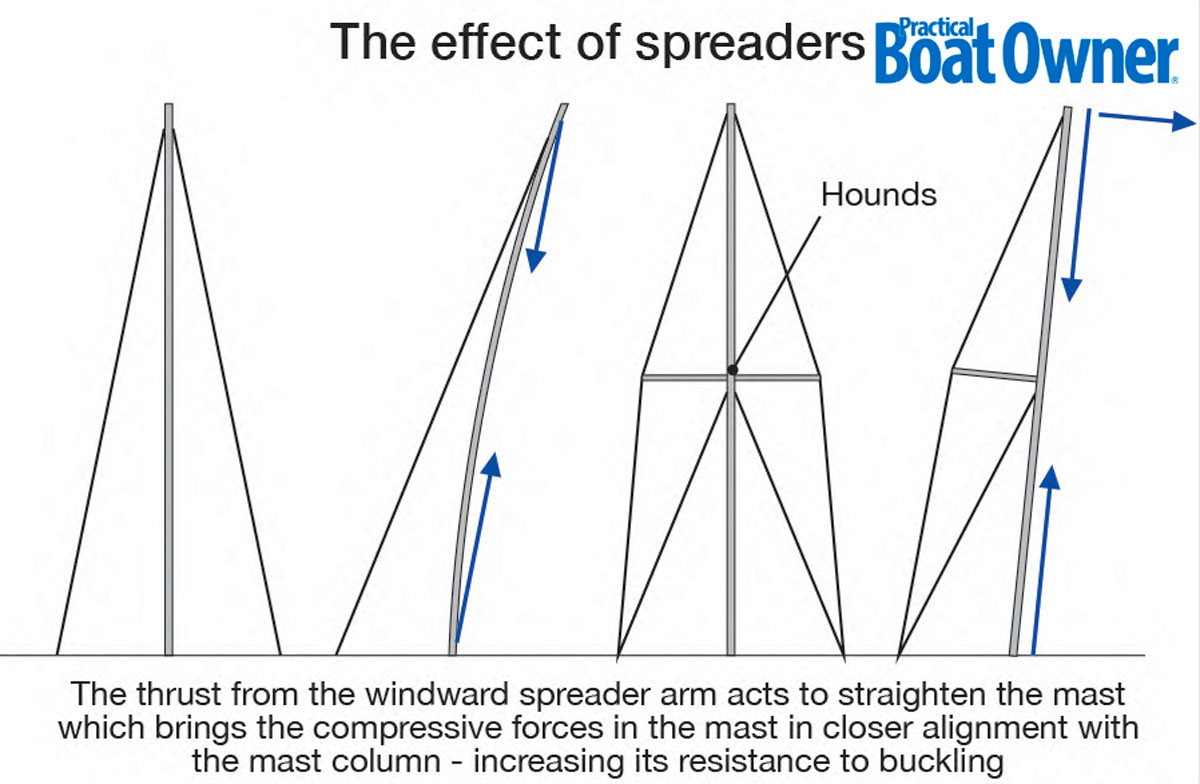
Boat rigging: The effect of spreaders
The illustration above shows how spreaders use the tension in the windward cap shroud to push against the mast, reducing its deflection and effectively dividing the mast into sections of reduced slenderness and hence increased resistance to buckling; and a through-deck, keel stepped mast has an inherently greater resistance to buckling than a deck stepped mast.
Why pre-tension matters for boat rigging
So far, so straightforward: I have summarised in the previous two pages the sum total of my previous knowledge of the mechanics of yacht masts and rigging.
So, for further enlightenment, I turned to the back issues of PBO (where else?). I found a number of useful articles, including David Harding’s How to Tune Your Rig, which covered the dark art of pre-tensioning the rig.
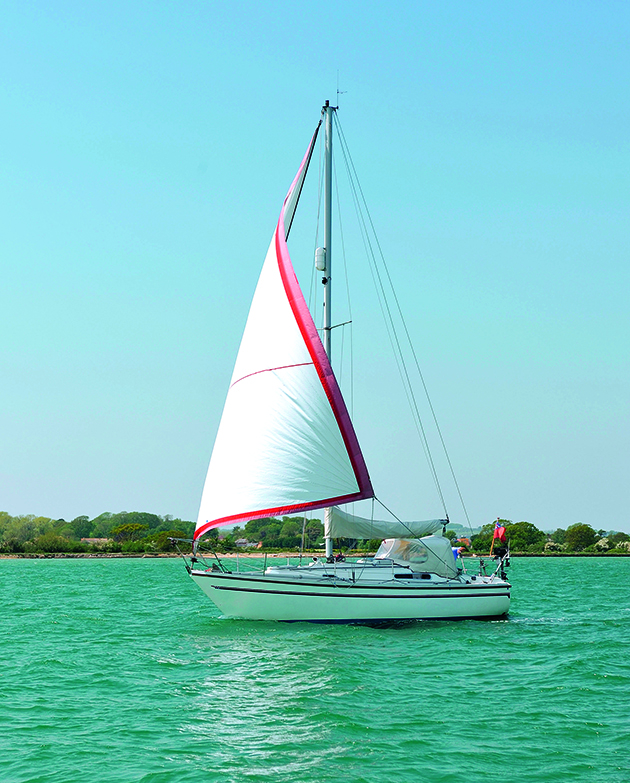
Under foresail loading, a pre-tensioned mast suffers much less deflection than one without pre-tension. Credit: Rick Buettner/Alamy
With the correct pre-tension, the leeward shrouds should not go slack, unlike those on my yacht, so it was a no-brainer that my rig didn’t have enough pre-tension.
He then went on to say that on boats like mine, with fractional rigs (where the forestay attaches between 1/8th and 1/4 below the masthead), it’s vital to keep the cap shrouds tight to tension the forestay, preventing it sagging too much; and further, that an under-tensioned rig risked damaging shock loads due to mast movement.
So far, so good, I could understand all that.
But when he quoted a spokesperson from Loos and Co – “The lateral stiffness of the mast… is reduced by a factor of 2 when the leeward shrouds go slack” – the mists came down and the grey matter stalled. I simply couldn’t see how pre-tensioning the cap shrouds stiffened the mast.
Stiffening the mast
The way I saw it, the windward shrouds would develop just sufficient extra tension to match the wind force on the sails.
This extra tension would be additional to the initial pre-tension, but the mast deflection (which equates to mast stiffness) would be the same as if the shrouds had no pre-tension and were just taut initially – wouldn’t it?
Well, to cut a long story short, no, it wouldn’t, as I shall show in the remainder of this article.
I was looking for a simple but realistic way to check the effect of pre-tension on mast deflection.
Specifically, its effect on our yacht’s mast. I started with Chapter 10 of PYD (the Principles of Yacht Design by Lars Larsson and Rolf E Eliasson) to find a rough estimate for the wind forces acting on the mast.
The standard approach outlined in PYD (which is based on the Nordic Boat Standard) is to consider two limiting loading cases: a) foresail only; or b) deeply reefed mainsail only.
I chose to investigate loading case a) – effectively a sideways pull on the mast from the forestay – it seemed the simplest.
The forestay’s pull is assumed to be proportional to RM30 (the yacht’s righting moment at 30° heel). No surprise there – I’d already gathered that a yacht’s heel resulted from the windward shroud’s tension at the chainplates.
If I had the yacht’s stability curve, it would be a simple matter to calculate RM30, but I didn’t have one.
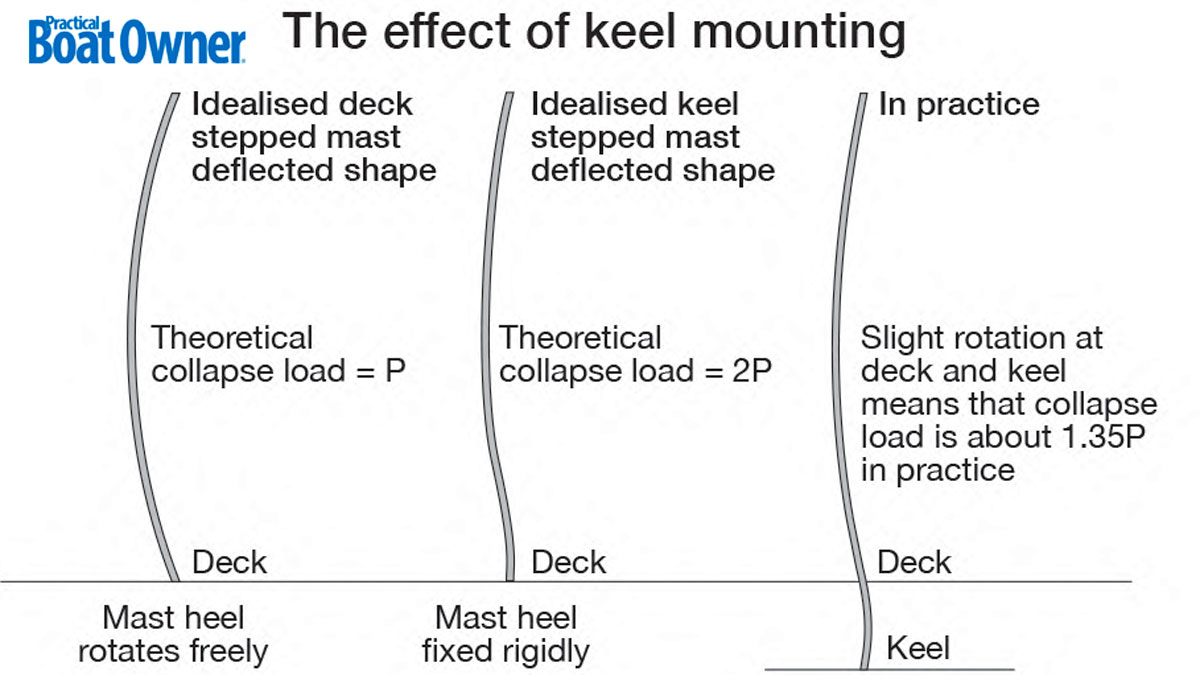
Boat rigging: The effect of keel mounting
So instead, as the yacht was on our drive for the winter, I traced out the hull lines and calculated RM30 using a yacht stability spreadsheet I wrote years ago (see diagram above).
For my Eagle 525, I estimated RM30 to be roughly 518kg.m.
Since the cap shrouds are about 6.4m above the waterline, the heeling force from the foresail is about 81kg (following the method set out in PYD).
Let’s say 100kg – it keeps the arithmetic tidy.
Applying this to a small computer model of the mast and shrouds, Figure 5 (see diagram below), using the computer program LISA (www.lisafea.com) gave the results on the table ‘Forces on mast and rigging under foresail load’.
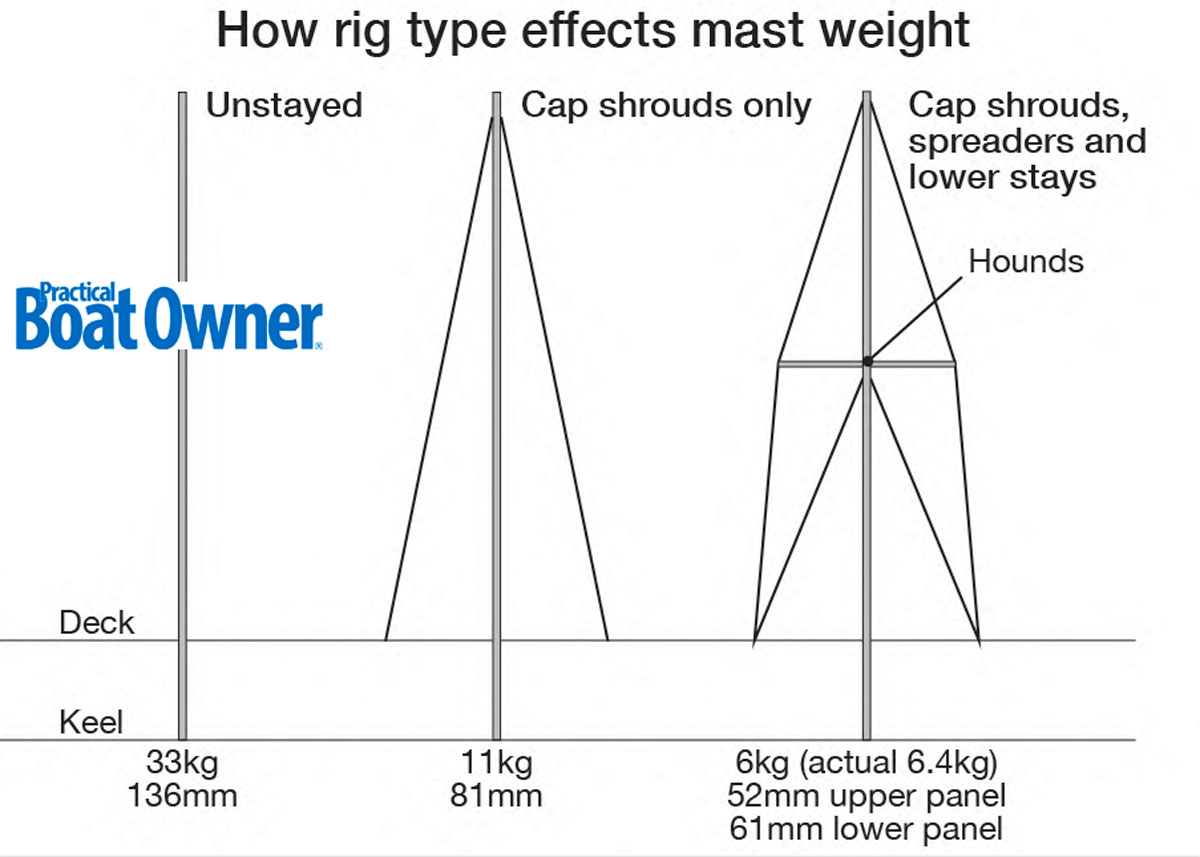
Figure 5: How rig types affect mast weights
And it is the table that illustrates how the pre-tension magic trick is performed.
With pre-tension, all the figures for tension and compression (the first 7 rows of the Forces on mast and rigging under foresail load list below) are increased, compared to the non-pre-tensioned example.
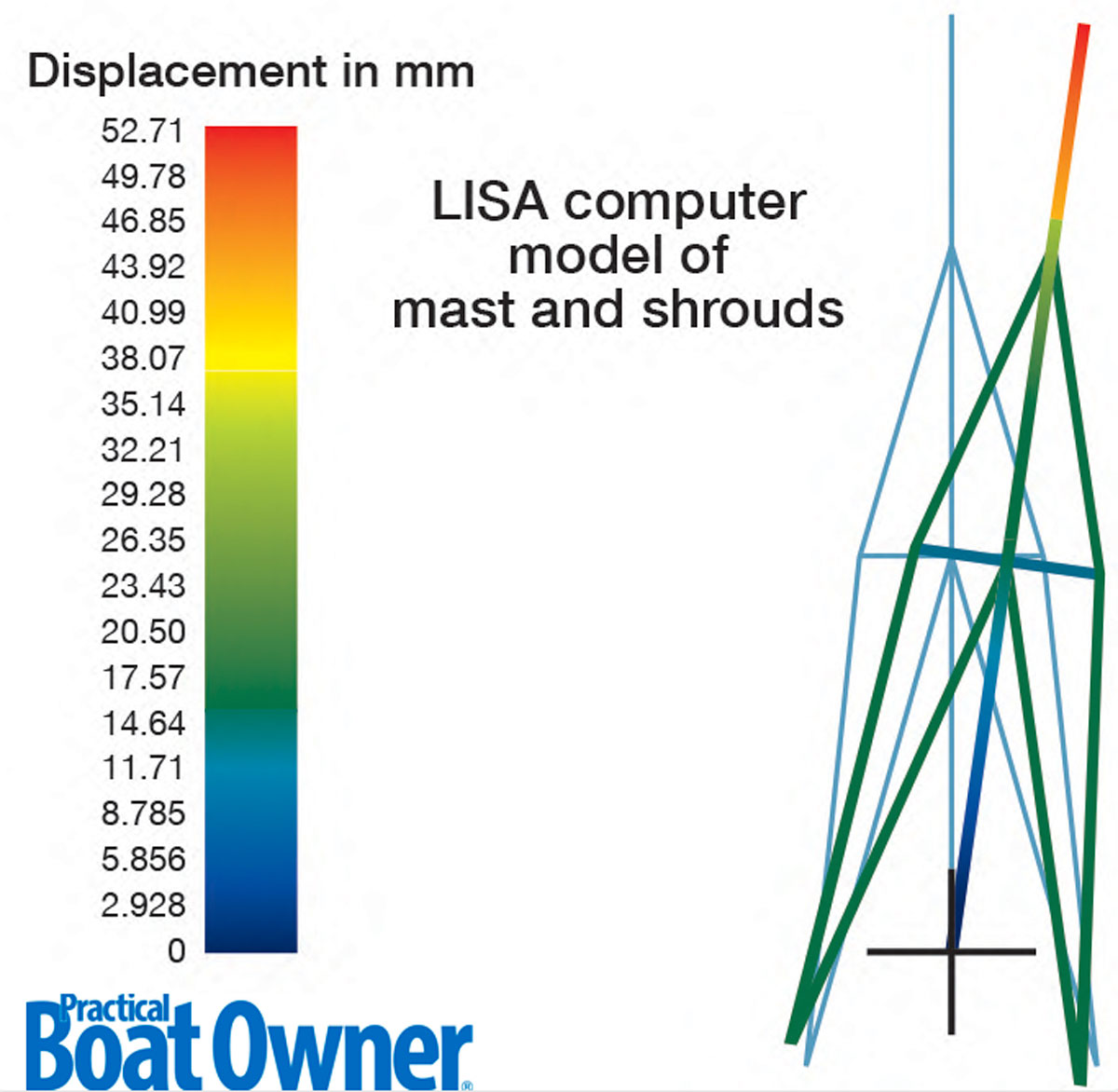
Figure 7
However, the pay-off is in the comparison between the deflection (Figure 7 above), which is measured in millimetres.
The non-pre-tensioned mast deflects twice as much as the pre-tensioned one.
Figure 6 (below) illustrates how, even though the pretensioned mast (C & D) is always more stressed, there is a smaller ‘surge’ of pressure on the rigging of mast D compared to mast B when the wind force jumps from 0kg to 100kg.
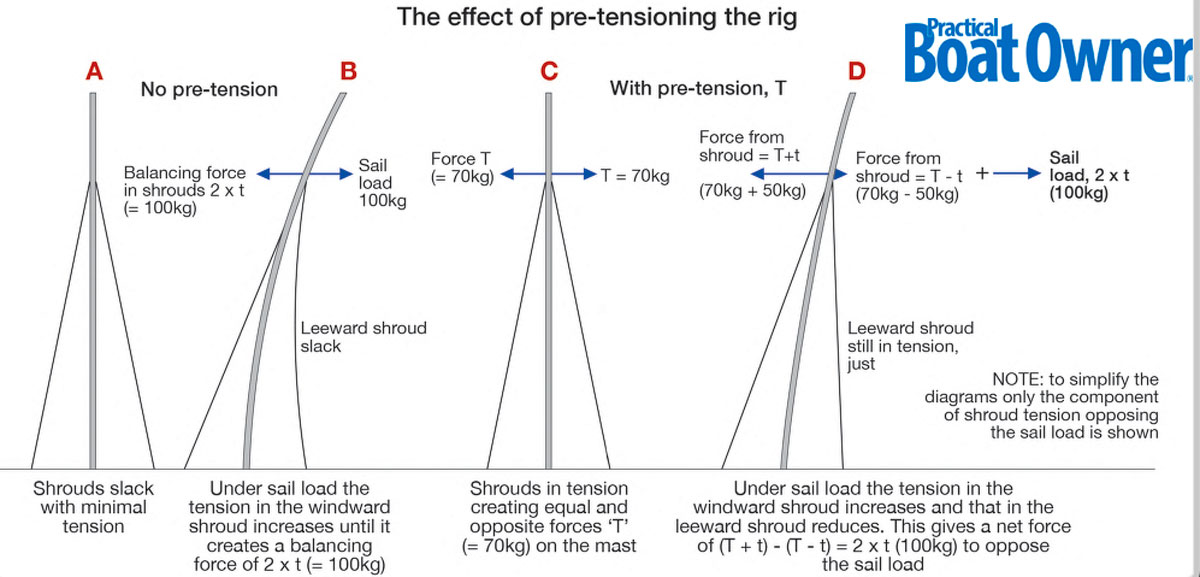
Figure 6
It’s important to bear in mind that these results arise from a much simplified model of the mast and standing rigging. Fore and aft forces and deflections have been ignored.
Only sideways forces and deflections have been considered.
The bending stiffness of the mast has been ignored. Its deflection is assumed to be resisted only by the shrouds.
But it confirms that the deflection of the mast is halved when the leeward shrouds are pre-tensioned – just as Loos and Co had said.
The results also allowed me to see how the pre-tension magic trick is performed. It shows that without pre-tension, the stretch induced in the windward shroud’s wire, and hence the mast’s deflection, will be twice what it would be if the shrouds had been pre-tensioned.
Forces on mast and rigging under foresail load
With pre-tension:
Tension in windward cap shroud (4mm diameter): (27% MBL*) 360kg
Tension in windward lower shroud (3mm diameter): (34% MBL*) 260kg
Compression in windward spreader arm: 53kg
Tension in leeward cap shroud: 8kg
Tension in leeward lower shroud: 52kg
Compression in mast between cap shroud and hounds: 330kg
Compression in mast below hounds: 660kg
Lateral deflection of mast at tip: 53mm
Lateral deflection of mast at hounds: 35mm
No pre-tension:
Tension in windward cap shroud (4mm diameter): (25% MBL*) 340kg
Tension in windward lower shroud (3mm diameter): (29% MBL*) 220kg
Compression in windward spreader arm: 50kg
Tension in leeward cap shroud: Slack kg
Tension in leeward lower shroud: Slack kg
Compression in mast between cap shroud and hounds: 320kg
Compression in mast below hounds: 550kg
Lateral deflection of mast at tip: 106mm
Lateral deflection of mast at hounds: 70mm
*MBL is the minimum breaking load taken from www.s3i.co.uk/1×19.php.
How to set up your rig: tension your shrouds on masthead or fractional
How to set up your rig: tension your shrouds on masthead or fractional If boats were cars, many of those…
Rig tuning: a practical guide for sailors
Correct rig tension will maximise the efficiency of your boat’s sails as well as reduce stresses on the mast. David…
How to do a rig check with an action cam
Simone Annunziata gets a bird’s eye view using modern tech and an old broom
Sail boat rigs: the pros and cons of each popular design
Peter Poland looks at the history of popular rig designs and how the different types affect boat performance
Want to read more articles like Understanding and mastering boat rigging?
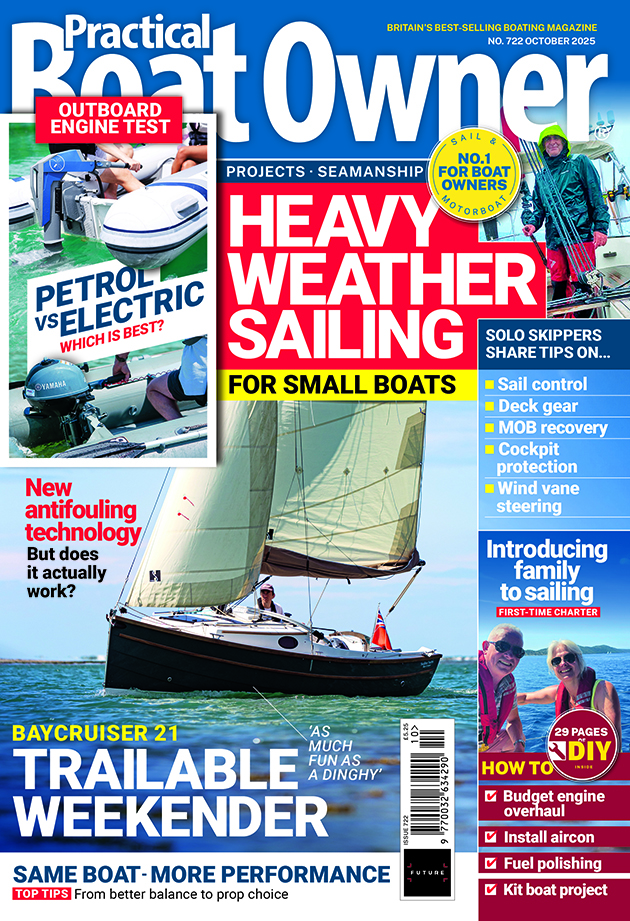
A subscription to Practical Boat Owner magazine costs around 40% less than the cover price.
Print and digital editions are available through Magazines Direct – where you can also find the latest deals.
PBO is packed with information to help you get the most from boat ownership – whether sail or power.
-
-
-
- Take your DIY skills to the next level with trusted advice on boat maintenance and repairs
- Impartial, in-depth gear reviews
- Practical cruising tips for making the most of your time afloat
-
-
Follow us on Facebook, Instagram, TikTok and Twitter

